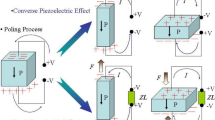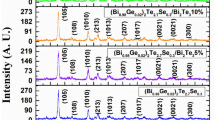Abstract
Bismuth pyrochlore ceramics have modest temperature coefficients of capacitance, good microwave properties, and can be prepared at relatively modest temperatures (~900 - 1100 °C). This work focuses on the preparation and characterization of thin films in this family for the first time. A sol-gel procedure using bismuth acetate in acetic acid and pyridine, in combination with zinc acetate dihydrate and niobium ethoxide in 2-methoxyethanol was developed. The solution chemistry was adjusted to prepare (Bi1.5Zn0.5)(Zn0.5Nb1.5)O7 and Bi2(Zn1/3Nb2/3)2O7 films. Solutions were spin-coated onto platinized Si substrates and crystallized by rapid thermal annealing. In both cases, crystallization occurred by 550 °C into the cubic pyrochlore structure. (Bi1.5Zn0.5)(Zn0.5Nb1.5)O7 films remained in the cubic phase up to crystallization temperatures of 750 °C, while the structure of the Bi2(Zn1/3Nb2/3)2O7 thin films is dependent of the firing temperature: cubic below 650 °C and orthorhombic above 750 °C. A mixture of cubic and orthorhombic structures is found at 700 °C. The resulting BZN films are dense, uniform, and smooth (rms roughness of < 5 nm). Cubic bismuth zinc niobate films show dielectric constants up to 150, a negative temperature coefficient of capacitance, TCC, (~ - 400 ppm/°C), tan δ < 0.01, and a field tunable dielectric constant. Orthorhombic films showed smaller dielectric constants (~80), low tan δ (< 0.01), positive TCC, and field independent dielectric constants. TCC could be adjusted to new 0 ppm/°C using a mixture of orthorhombic and cubic material.
Similar content being viewed by others
References
M. F. Yan, H. C. Ling, and W. W. Rhodes, J. Am. Ceram. Soc., 73, 1106 (1990).
D. Liu, Y. Liu, S. Huang, and X. Yao, J. Am. Ceram. Soc., 76, 2129 (1993).
D. P. Cann, C. A. Randall, and T. R. Shrout, Solid State Comm., 100, 529 (1996).
X. Wang, H. Wang, and X. Yao, J. Am. Ceram. Soc., 80, 2745 (1997).
H. Kagata, T. Inoue, J. Kato, and I. Kameyama, Jpn. J. Appl. Phys., 31, 3152 (1992).
S. L. Swartz, and T. R. Shrout, “Ceramic compositions for BZN dielectric resonators,” U. S. Patent, No. 5449652 (1995).
D. P. Cann, “Bismuth pyrochlores for high frequency dielectric applications,” MS Thesis, The Pennsylvania State University (1993).
E. Courtens, Phys. Rev. Lett, 52, 69 (1984).
U. T. Höchli, Phys. Rev. Lett., 48, 1494 (1982).
S. Bhattacharya, S. R. Nagel, L. Fleishman and S. Susman, Phys. Rev. Lett., 18, 1267 (1982).
D. Huser, L.E. Wenger, A. J. van Duyneveldt, and J. A. Mydosh, Phys. Rev. B 27, 3100 (1983).
Author information
Authors and Affiliations
Rights and permissions
About this article
Cite this article
Ren, W., Thayer, R., Randall, C.A. et al. Bismuth Pyrochlore Films for Dielectric Applications. MRS Online Proceedings Library 603, 137–142 (1999). https://doi.org/10.1557/PROC-603-137
Published:
Issue Date:
DOI: https://doi.org/10.1557/PROC-603-137




